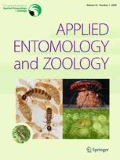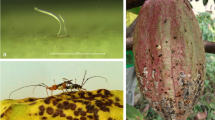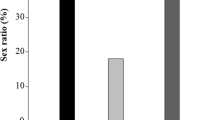Abstract
Under laboratory conditions, we investigated the host suitability of 24 poaceous plants for Trigonotylus caelestialium (Kirkaldy) and Stenotus rubrovittatus (Matsumura). More than 50 % of the nymphs of both bugs reached the adult stage on Poa annua L., Alopecurus aequalis Sobol. var. amurensis (Komar.), Poa sphondylodes Trin., Hordeum murinum L., Agrostis clavata Trin. ssp. matsumurae (Hack. ex Honda), and Lolium multiflorum Lam. In addition, a similar number of S. rubrovittatus nymphs reached the adult stage on Dactylis glomerata L. and Digitaria violascens Link. However, a high percentage of T. caelestialium adults emerged on both spikelets and leaves of the host plants, whereas a lower percentage of S. rubrovittatus adults emerged on leaves than on spikelets. While the numbers of T. caelestialium adults that emerged on spikelets and leaves were similar, those reared on spikelets had a shorter developmental period and longer forewings than those reared on leaves, indicating that spikelets were more suitable for growth. In addition, more adults of both species emerged on plants with ears that arise during the spring and early summer than on plants with ears that arise during the summer and fall. Therefore, the development of these bugs is dependent on the season of ear emergence.



Similar content being viewed by others
References
Bernays EA, Chapman RF (1994) Host-plant selection by phytophagous insects. Chapman & Hall, New York
Digweed SC (2006) Oviposition preference and larval performance in the exotic birch-leafmining sawfly Profenusa thomsoni. Entomol Exp Appl 120:41–49
Douglas WA, Tullis EC (1950) Insects and fungi as causes of pecky rice. US Dep Agric Tech Bull 1015:1–20
Eben A, López-Carretero A (2008) Asymmetry of larval diet breadth and oviposition preference in Leptinotarsa undecimlineata. Entomol Exp Appl 128:27–33. doi:10.1111/j.1570-7458.2008.00696.x
Gratton C, Welter SC (1998) Oviposition preference and larval performance of Liriomyza helianthi (Diptera: Agromyzidae) on normal and novel host plants. Environ Entomol 27:926–935
Hachiya K (1999) Migration of rice leaf bug, Trigonotylus caelestialium (Kirkaldy) into rice fields and forecasting of the abundance. Plant Prot 53:268–272 (in Japanese)
Hayashi H (1986) Ecology and control of the sorghum plant bug (Stenotus rubrovittatus Matsumura) causing the pecky rice. Plant Prot 40:321–326 (in Japanese)
Hayashi H, Nakazawa K (1988) Studies on the bionomics and control of the sorghum plant bug, Stenotus rubrovittatus Matsumura (Hemiptera: Miridae) 1. Habitat and seasonal prevalence in Hiroshima Prefecture. Bull Hiroshima Agric Exp Stn 51:45–53 (in Japanese with English summary)
Higuchi H, Takahashi A (2000) Method of rearing the rice leaf bug, Trigonotylus caelestialium (Kirkaldy) (Heteroptera: Miridae) with wheat seedlings. Proc Assoc Plant Prot Hokuriku 48:23–25 (in Japanese)
Ingram JW (1927) Insects injurious to the rice crop. US Dep Agric Farmers Bull 1543:1–16
Ishimoto M (2004) Seasonal prevalence of occurrence of the rice leaf bug, Trigonotylus caelestialium (Kirkaldy) (Heteroptera: Miridae) on paddy rice plants. Jpn J Appl Entomol Zool 48:79–85 (in Japanese with English summary)
Ishimoto M (2007) Effects of the ripening stage and the occurrence of split-hull paddy of rice plant on development of nymphs of the rice leaf bug, Trigonotylus caelestialium (Kirkaldy) (Heteroptera: Miridae). Jpn J Appl Entomol Zool 51:107–114. doi:10.1303/jjaez.2007.107 (in Japanese with English summary)
Ishimoto M (2008) Development of sorghum plant bug, Stenotus rubrovittatus (Matsumura) (Heteroptera: Miridae) nymphs reared on hulled rice. Jpn J Appl Entomol Zool 52:139–141. doi:10.1303/jjaez.2008.139 (in Japanese with English summary)
Ishimoto M (2011) Oviposition of sorghum plant bug, Stenotus rubrovittatus (Matsumura) (Heteroptera: Miridae) on rice plants. Jpn J Appl Entomol Zool 55:193–197. doi:10.1303/jjaez.2011.193 (in Japanese with English summary)
Ishimoto M, Sato H (2006) Effects of supplying grains as supplementary food on development of nymphs and fecundity of adults of rice leaf bug, Trigonotylus caelestialium (Kirkaldy) (Heteroptera: Miridae). Jpn J Appl Entomol Zool 50:305–310. doi:10.1303/jjaez.2006.305 (in Japanese with English summary)
Ito K (1978) Ecology of the stink bugs causing pecky rice. Rev Plant Prot Res 11:62–78
Kato S, Hasegawa H (1950) Calocoris rubrovittata Mats., a new pest of Sorghum sudanense. Oyo Kontyu 6:149 (in Japanese)
Kawasawa T, Kawamura M (1977) Kamemushi Hyakushu. Zenkoku Nouson Kyouiku Kyoukai, Tokyo (in Japanese)
Kikuchi A, Kobayashi T (2001) Effect of weed mowing on the abundance of Trigonotylus caelestialium (Kirkaldy) (Heteroptera: Miridae). Annu Rep Plant Prot North Japan 52:143–145 (in Japanese)
Kikuchi A, Kobayashi T (2004) Growth and oviposition of the rice leaf bug, Trigonotylus caelestialium (Kirkaldy) (Heteroptera: Miridae), on gramineous weeds and Italian rye grass. Annu Rep Plant Prot North Japan 55:149–154 (in Japanese)
Monma Y, Kikuchi A (2004) The development and preference of the rice leaf bug, Trigonotylus caelestialium (Kirkaldy) (Heteroptera: Miridae), for ground cover plants. Annu Rep Plant Prot North Japan 55:128–130 (in Japanese)
Nagasawa A (2007) Gramineous plants used as oviposition sites by pecky rice bugs, Trigonotylus caelestialium (Kirkaldy) and Stenotus rubrovittatus (Matsumura) (Heteroptera: Miridae). Proc Assoc Plant Prot Hokuriku 56:29–31 (in Japanese)
Nagasawa A, Higuchi H (2008) A method for rearing Stenotus rubrovittatus (Matsumura) (Heteroptera: Miridae) by using the spikelets of gramineous weeds as oviposition sites and wheat seedlings for rearing nymphs. Jpn J Appl Entomol Zool 52:1–6. doi:10.1303/jjaez.2008.1 (in Japanese with English summary)
Nagasawa A, Higuchi H (2010) Storage of stem cuttings of wheat seedlings under high-humidity conditions to improve larval emergence after oviposition by Stenotus rubrovittatus (Matsumura) (Heteroptera: Miridae). Jpn J Appl Entomol Zool 54:197–203. doi:101.1303/jjaez.2010.197 (in Japanese with English summary)
Nagasawa A, Takahashi A, Higuchi H (2012) Host plant use for oviposition by Trigonotylus caelestialium (Hemiptera: Miridae) and Stenotus rubrovittatus (Hemiptera: Miridae). Appl Entomol Zool. doi:10.1007/s13355-012-0123-9
Niiyama T, Itoyama K (2006) Control of rice leaf bug, Trigonotylus caelestialium (Heteroptera: Miridae) by application of herbicide to their source of immigration. Annu Rep Plant Prot North Japan 57:129–133 (in Japanese)
Ono T, Kashin J, Kidokoro T (2007) Control of sorghum plant bug, Stenotus rubrovittatus (Matsumura) (Hemiptera: Miridae), in rice paddy field by grass mowing in relation to migration source. Annu Rep Plant Prot North Japan 58:75–79 (in Japanese)
Osada T (1993) Illustrated grasses of Japan. Heibonsha, Tokyo (in Japanese and English)
R Development Core Team (2010) R: a language and environment for statistical computing. R Foundation for Statistical Computing, Vienna
Roininen H, Tahvanainen J (1989) Host selection and larval performance of two willow-feeding sawflies. Ecology 70:129–136
Sato H, Ishimoto M, Yokoyama Y (2009) Seasonal prevalence of the sorghum plant bug, Stenotus rubrovittatus (Heteroptera: Miridae), in Niigata prefecture. Proc Assoc Plant Prot Hokuriku 58:7–12 (in Japanese)
Schoonhoven LM, van Loon JJA, Dicke M (2005) Insect–plant biology. Chapman & Hall, London
Shintani Y (2009) Effect of seasonal variation in host-plant quality on the rice leaf bug, Trigonotylus caelestialium. Entomol Exp Appl 133:128–135. doi:10.1111/j.1570-7458.2009.00915.x
Takita M (2005) Fluctuation in the number of males of the rice leaf bug, Trigonotylus caelestialium (Kirkaldy) (Heteroptera: Miridae), captured by synthetic sex pheromone traps placed in fields overgrown with weeds. Proc Assoc Plant Prot Hokuriku 54:19–22 (in Japanese)
Watanabe T, Higuchi H (2006) Recent occurrence and problem of rice bugs. Plant Prot 60:201–203 (in Japanese)
Watanabe K, Ishii S, Domon K (2002) Control of the rice leaf bug, Trigonotylus caelestialium (Kirkaldy) (Heteroptera: Miridae), by cultivating upland field. Annu Rep Plant Prot North Japan 53:168–172 (in Japanese)
Wennström A, Hjulström LN, Hjältén J, Julkunen-Tiitto R (2010) Mother really knows best: host choice of adult phytophagous insect females reflects a within-host variation in suitability as larval food. Chemoecology 20:35–42. doi:10.1007/s00049-010-0040-8
Yokota H, Suzuki T (2007) Effects of heading frequency of gramineous weeds on population density of Stenotus rubrovittatus in footpath between paddy fields. Annu Rep Plant Prot North Japan 58:88–91 (in Japanese)
Yokota H, Suzuki T (2008) Most effective timing of mowing on the population density of the nymphs of the overwintering generation of Stenotus rubrovittatus in the footpath between paddy fields. Annu Rep Plant Prot North Japan 59:116–119 (in Japanese)
Acknowledgments
We thank Dr. A. Takahashi of Hokuriku Research Center, NARO Agricultural Research Center, and Dr. M. Ishimoto of Niigata Agricultural Research Institute, Crop Research Center, for their valuable suggestions. The authors declare that they have no conflict of interest.
Author information
Authors and Affiliations
Corresponding author
Rights and permissions
About this article
Cite this article
Nagasawa, A., Higuchi, H. Suitability of poaceous plants for nymphal growth of the pecky rice bugs Trigonotylus caelestialium and Stenotus rubrovittatus (Hemiptera: Miridae) in Niigata, Japan. Appl Entomol Zool 47, 421–427 (2012). https://doi.org/10.1007/s13355-012-0135-5
Received:
Accepted:
Published:
Issue Date:
DOI: https://doi.org/10.1007/s13355-012-0135-5




